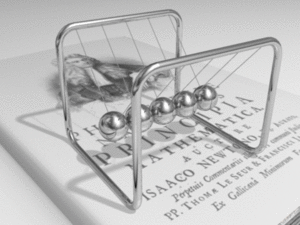Momentum facts for kids

Momentum is like the "power" an object has when it's moving. It shows how much force a moving object can put on another object. Think of it this way: a heavy bowling ball rolled very slowly might not break a glass door. But a small baseball thrown very fast can easily break the same door! The baseball has more momentum than the bowling ball in this case.
Momentum depends on two things: how heavy an object is (its mass) and how fast it's moving (its velocity). So, a heavy object moving slowly can have the same momentum as a light object moving very fast. For example, a tiny bullet has huge momentum because it moves at an amazing speed.
Momentum is a vector quantity. This means it has both a size (how much momentum) and a direction. The unit for momentum is kilogram metre per second (kg m/s). Sometimes it's called linear momentum to tell it apart from angular momentum, which is about spinning objects.
Momentum is also a conserved quantity. This means that in a closed system, the total amount of momentum always stays the same. It doesn't get lost or gained.
Contents
What is the Formula for Momentum?
In physics, the letter p stands for momentum. The formula for momentum is:
Here, p is the momentum, m is the mass of the object, and v is its velocity.
This formula tells us that if you know an object's mass and how fast it's going, you can figure out its momentum.
What is Impulse?
Impulse is what happens when a force causes a change in an object's momentum. Imagine you're pushing a swing. When you push it, you apply a force, and the swing's momentum changes.
- If you push the swing in the direction it's already moving, its momentum will increase. It will go faster.
- If you push against the swing's motion, its momentum will decrease. It will slow down.
So, impulse is basically the effect of a force acting over a period of time, which changes an object's momentum.
What is the Law of Conservation of Momentum?
The Law of Conservation of Momentum is a very important rule in physics. It says that the total momentum of a system of objects stays constant if no outside forces act on it.
To understand this, remember that momentum has a direction. We add up momentum using vector addition. This means if you have momentum going in one direction and the same amount of momentum going in the exact opposite direction, they cancel each other out, and the total momentum is zero.
Gun Firing Example
Think about a gun being fired.
- A small bullet shoots forward at a very high speed. It has momentum in that direction.
- At the same time, the much heavier gun kicks backward (this is called recoil) at a much slower speed. It has momentum in the opposite direction.
The momentum of the bullet and the momentum of the gun are exactly equal in size but point in opposite directions. When you add them together using vector addition, the total momentum of the gun-bullet system is zero. This means the momentum of the system was conserved! It started at zero (before firing) and remained zero (after firing, considering both parts).
Car and Truck Collision Example
Let's look at a collision:
- A car (mass = 1000 kg) is moving right at 8 m/s.
- A truck (mass = 6000 kg) is moving left at 2 m/s.
We can calculate their momentum:
- Car's momentum: 1000 kg x 8 m/s = 8000 kg m/s (going right)
- Truck's momentum: 6000 kg x -2 m/s = -12000 kg m/s (going left, so we use a negative sign for direction)
Now, let's find their total momentum before the crash:
- Total momentum = 8000 kg m/s + (-12000 kg m/s) = -4000 kg m/s
This means the total momentum of the car and truck system is 4000 kg m/s going left. According to the Law of Conservation of Momentum, after they crash, their combined momentum will still be -4000 kg m/s. This is why the car and truck will be moving left after the collision.
Images for kids
See also
 In Spanish: Cantidad de movimiento para niños
In Spanish: Cantidad de movimiento para niños




